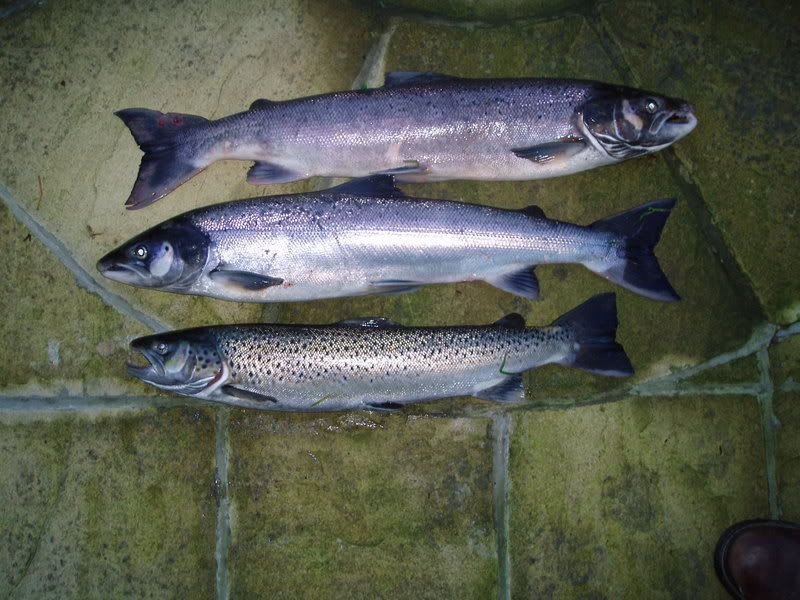Post by fenton on Aug 27, 2007 12:31:33 GMT
I was introduced to these by my early 'salmon fishing mentor'. They represent a simple and successful tube fly. The body consists of chrome car aerial sections cut to the desired length, and then lined with some sort of plastic liner. To my mind they have the following points in their favour;
1) They are cheap to produce. I recently procured 7 car aerials from the local scrappy, and was asked for £1.
2) They give you a wide range of options. You can cut them to whatever length you want, and you have a range of diameters. The larger diameters can be lined with say a slip stream copper tube to add extra weight.
3) A very simple pattern can be very effective, and need consist of no more than a couple of bunches of buck tail tied in at the head.
4) They are very shiny!
I have put together a sketchy step by step of one of my favourite patterns. This is aimed at the beginner , and maybe a tad simplistic and rather boring for some of the Gurus we are lucky enough to have on this forum. I'm afraid that I am also somewhat struggling with my digital camera.....
The following pattern simply consists of car aerial tube, black tying thread and brown and orange buck tail. Jungle cock cheeks are optional. Although this is a fairly nondescript fly, I have done well on it on the Tweed and the Whiteadder. A plain brown version is also effective.
Step 1), find your aerial, and cut to size.Smooth off the cut ends.
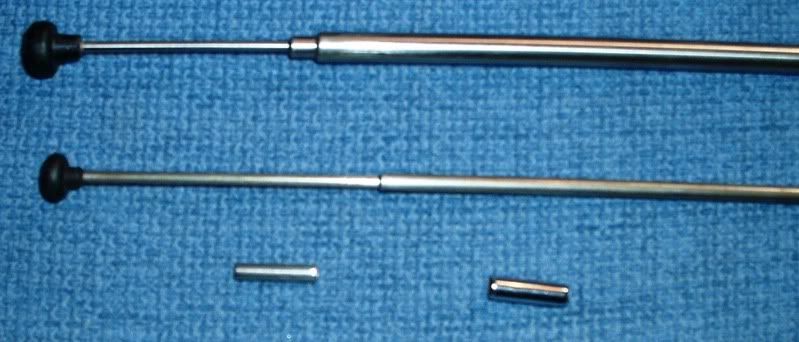
Step 2) Line your aerial tube with a plastic liner.
Obviously the liner used depends on the diameter of the aerial. I have used conehead tubing, (empty) inserts from biro pens, plastic tubing used to make booms for sea fishing tackle, and also various bits of plastic tubing from work (catheters etc).
Leave about 3 or 4 mm of the lining tubing sticking out beyond the 'tail' end of the aerial. Depending on the diameter of your liner, this will either directly form your extension for mounting your treble, or will allow you to place some extension tubing over the liner. Melt the head end of the liner with a lighter (as for coneheads)
The tube on the left in the picture below is lined with a black plastic liner, and some extension tubing has been added at the tail. The tube on the left is lined with clear plastic, and the diameter is perfect to allow the liner to also act as an extension.
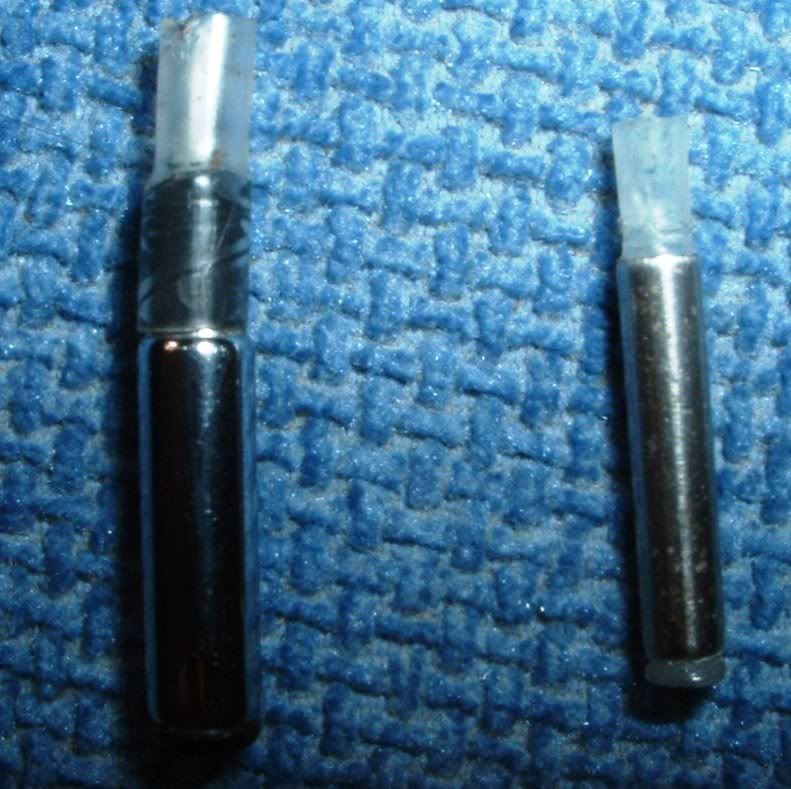
The tube is now ready to be tied.
Step 3) Add a touch of varnish to the head of the tube, before tying on your black tying thread. It is difficult to get thread to purchase on the chrome tube, and the varnish just helps to secure things. Then tie in a bunch of brown or brown and orange bucktail. I normally add another wee drop of varnish at this point before trimming the excess bucktail with a scalpel blade.

Spin the fly around in the vice and add another similar bunch of bucktail at 6 o'clock.
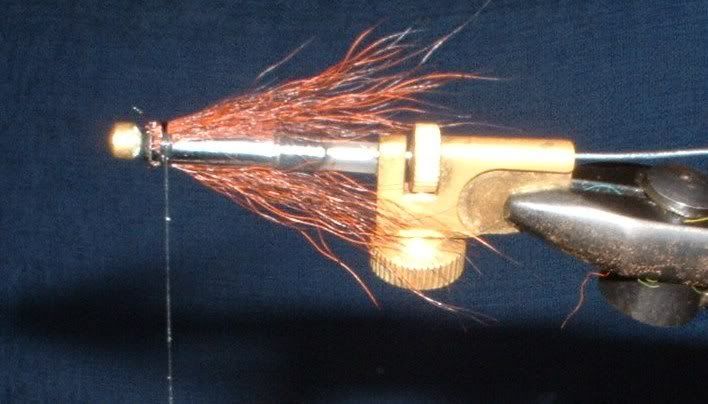
Add your jungle cock cheeks if you wish. (I'm afraid they don't show up too well in this photo)
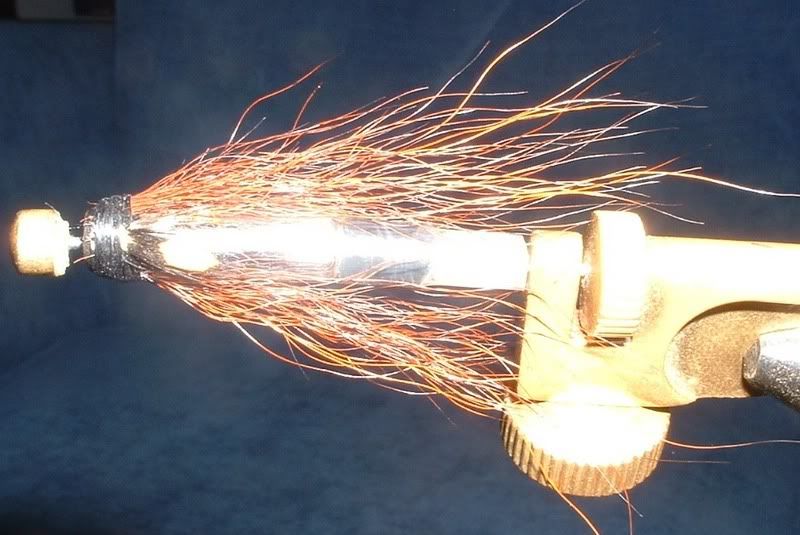
Finish your head and varnish.
The car aerial tubes also lend themselves well to shrimp patterns, as this Black ally aerial tied by the late Mick Williams shows;
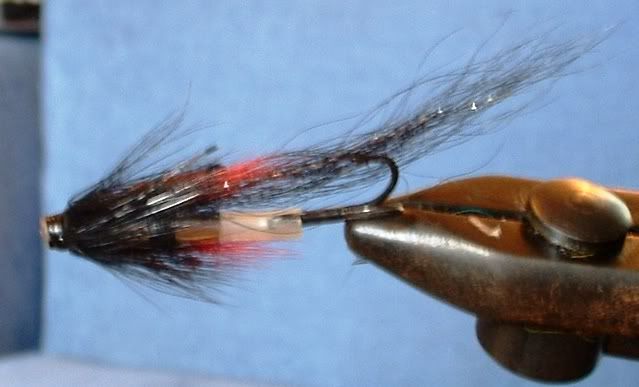 .
.
Finally these wee fella, again tied by Mick, is another favourite. It is made of the thinnest (top portion) of an aerial. There is a section on the beat we fish which consists of a long stretch of slow moving water between 3 and 6 feet deep. The following fly does well on this stretch when fished on a floating line and a long leader, with a slight twitchy retrieve. I have seen my mentor do very well using this method in low clear water.
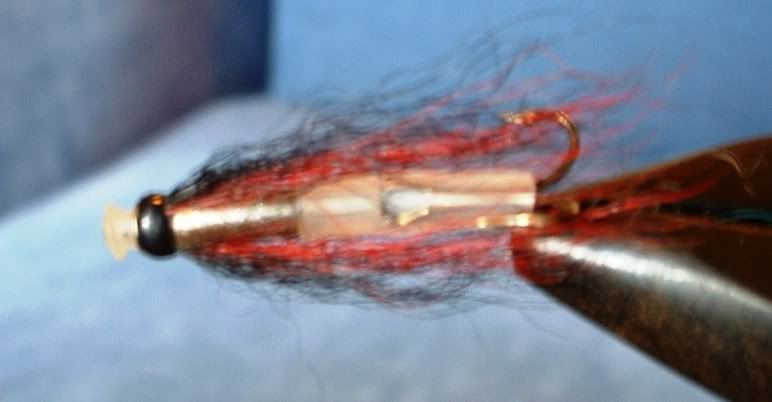
Comments and constructive criticism very welcome as always,
Cheers
Fenton
1) They are cheap to produce. I recently procured 7 car aerials from the local scrappy, and was asked for £1.
2) They give you a wide range of options. You can cut them to whatever length you want, and you have a range of diameters. The larger diameters can be lined with say a slip stream copper tube to add extra weight.
3) A very simple pattern can be very effective, and need consist of no more than a couple of bunches of buck tail tied in at the head.
4) They are very shiny!
I have put together a sketchy step by step of one of my favourite patterns. This is aimed at the beginner , and maybe a tad simplistic and rather boring for some of the Gurus we are lucky enough to have on this forum. I'm afraid that I am also somewhat struggling with my digital camera.....
The following pattern simply consists of car aerial tube, black tying thread and brown and orange buck tail. Jungle cock cheeks are optional. Although this is a fairly nondescript fly, I have done well on it on the Tweed and the Whiteadder. A plain brown version is also effective.
Step 1), find your aerial, and cut to size.Smooth off the cut ends.

Step 2) Line your aerial tube with a plastic liner.
Obviously the liner used depends on the diameter of the aerial. I have used conehead tubing, (empty) inserts from biro pens, plastic tubing used to make booms for sea fishing tackle, and also various bits of plastic tubing from work (catheters etc).
Leave about 3 or 4 mm of the lining tubing sticking out beyond the 'tail' end of the aerial. Depending on the diameter of your liner, this will either directly form your extension for mounting your treble, or will allow you to place some extension tubing over the liner. Melt the head end of the liner with a lighter (as for coneheads)
The tube on the left in the picture below is lined with a black plastic liner, and some extension tubing has been added at the tail. The tube on the left is lined with clear plastic, and the diameter is perfect to allow the liner to also act as an extension.

The tube is now ready to be tied.
Step 3) Add a touch of varnish to the head of the tube, before tying on your black tying thread. It is difficult to get thread to purchase on the chrome tube, and the varnish just helps to secure things. Then tie in a bunch of brown or brown and orange bucktail. I normally add another wee drop of varnish at this point before trimming the excess bucktail with a scalpel blade.

Spin the fly around in the vice and add another similar bunch of bucktail at 6 o'clock.

Add your jungle cock cheeks if you wish. (I'm afraid they don't show up too well in this photo)

Finish your head and varnish.
The car aerial tubes also lend themselves well to shrimp patterns, as this Black ally aerial tied by the late Mick Williams shows;
 .
.Finally these wee fella, again tied by Mick, is another favourite. It is made of the thinnest (top portion) of an aerial. There is a section on the beat we fish which consists of a long stretch of slow moving water between 3 and 6 feet deep. The following fly does well on this stretch when fished on a floating line and a long leader, with a slight twitchy retrieve. I have seen my mentor do very well using this method in low clear water.

Comments and constructive criticism very welcome as always,
Cheers
Fenton


